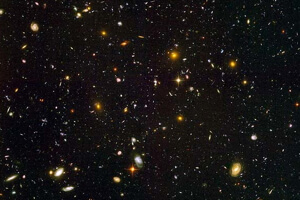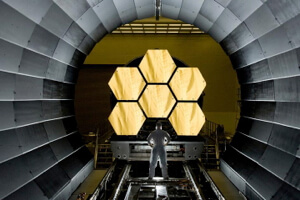Recently, NASA and ESA released the most detailed image yet of Andromeda, our closest galactic neighbor at 2.5 million light years away. Andromeda—which is expected to collide and merge with our own Milky Way galaxy in about four billion years—is estimated to contain a trillion stars. By comparison, our galaxy contains about 300 billion stars.
But numbers that big are a bit meaningless. Sometimes it takes an image like this one to really hammer the point home. You can zoom in and out with their interactive tool—but we suggest you check out the below video tour instead.
If this doesn’t blow your mind, nothing will.
Millions and millions of suns scattered like grains of sand, each one a system of dust and maybe planets like our own. And as the video scans into the galactic center—the sheer number of stars overwhelms the darkness. A fabric of light.
The image, taken by the Hubble telescope, uses 1.5 billion pixels to reveal about 100 million stars—a ten thousandth of the stars in the whole galaxy. It shows the startling scale of just our local neighborhood in the universe, and may be one of the most awe-inspiring images produced from the almost 25 years of service by the space telescope.
Of course, Hubble’s iconic Deep Field series is in the running too (perhaps number one all time).

While the Andromeda image gives us an idea of galactic scale, the Deep Field images gave us a sense of the scale of the universe. The Deep Field revealed thousands of galaxies in a tiny, completely dark sliver of sky about 1/30th the circumference of the Moon.
It’s estimated there are over 100 billion galaxies in the universe. So, hundreds of billions of stars in a galaxy—and a hundred billion galaxies. It’s a humbling perspective as significant as Copernicus putting the Sun at the center of the solar system or Carl Sagan’s pale blue dot.
The next generation James Webb Space Telescope, is scheduled for launch in 2018 and is expected to give us an even better view of deep space. A side-by-side comparison of the two primary mirrors shows that the collecting area of the James Webb telescope is over five times bigger than that of Hubble.

The James Webb will primarily collect images in the infrared instead of the visible spectrum. This will allow us to see the earliest stars and galaxies, whose light is red-shifted as it travels over enormous distances to reach us. What’s more, infrared light can more easily penetrate the clouds of gas and dust it inevitably must travel through.
As we await the James Webb telescope, it’s unclear how much longer Hubble will remain functional. NASA has no more plans to send humans to the telescope, even if it needs servicing (the last manned mission was in 2009). Even if NASA will develop robots capable of running an unmanned servicing mission in the near future, the cost might still make it prohibitive.
Nonetheless, Hubble has given us more than enough to chew on. Though it may not have the immediate urgency of Elon Musk’s call to Mars—scaling our universe is an important function of these technological wonders orbiting overhead.
Article written with contributions from Jason Dorrier.
Image Credit: NASA and ESA (Andromeda Galaxy, Hubble Ultra Deep Field, James Webb Space Telescope)



